- India
- International
Why experts say India does not need a population policy
India's experiments with population control go back to the years preceding Indepedence and presently experts say that not only have most targets been met but also the demographic situation is at an advantageous level.
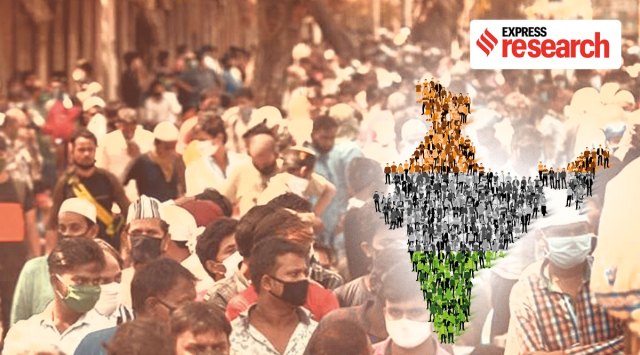 The Western gaze towards India, citing it as a case where overpopulation led to checks like famines, war and epidemics went a long way in shaping the Indian elite’s response to the country’s population. (Express Photo by Ganesh Shirsekar/ edited by Dinkar Sasi)
The Western gaze towards India, citing it as a case where overpopulation led to checks like famines, war and epidemics went a long way in shaping the Indian elite’s response to the country’s population. (Express Photo by Ganesh Shirsekar/ edited by Dinkar Sasi)India’s experimentations with fertility control programs go all the way back to the period preceding its Independence. In fact, it was one of the first countries to introduce an official programme of birth control intended to reduce the rate of population growth, but to this day the relative population size and fertility rates remain a contentious issue in electoral politics.
In July 2019, a Population Regulation Bill, proposing to introduce a two-child policy per couple, was introduced in the Rajya Sabha by BJP MP Rakesh Sinha. However, the Bill was withdrawn earlier this year following intervention by the Union health minister Mansukh Mandaviya who argued that NHFS and census data to show the positive impact of government-led awareness campaigns rather than force on indicators such as the Total Fertility Rate (TFR).
Experts too agree that at this juncture there is no requirement of a population control bill or any policy that enforces a fixed number of children a couple can have. “Whatever goals that the latest population policy, NPP 2000, had set have been achieved and the fertility level everywhere is going down,” reasons K Srinivasan, Emeritus Professor of International Institute of Population Sciences. “If we take the case of Tamil Nadu, the fertility levels there are well below replacement levels for the last 10-12 years. Its population is going to decline from 2031. Kerala’s population will also decline soon after,” he explains.
The Western gaze and early experiments with population control
The idea that the population of the Indian subcontinent was a problem emerged only from the third decade of the 20th century. “Much of the time that the British were in control, right up till the 1860s and 70s, they often took the view that there were not enough people,” says Tim Dyson, Professor Emeritus of Population Studies at the London School of Economics.
Srinivasan in his book, ‘Population concerns in India: Shifting trends, policies, and programs’ (2017) notes that the population of India within its present geographical boundaries in fact declined between 1911 and 1921 from 252.1 to 251.3 million on account of the global influenza pandemic of 1918-19. It is only from 1921 that the population rose due to measures undertaken by provincial governments. “Concerns over this rapid rise in population arose from four quarters: intellectuals, social reformers (especially those interested in improving the status of women), the Congress party (the leading political party that spearheaded the movement for political independence) and the government,” he writes.

The role of the Indian intellectual elite was particularly strong in this regard during the first two decades of the century. A large majority among them visited England for higher education and for training in posts for the Indian Civil Service. There they were introduced to Malthusian theories of population and Neo-Malthusian Leagues across Europe.
Historian Matthew Connelly in his article, ‘Population control in India: Prologue to the Emergency period’ (2006) notes that the Indian elites, and particularly the Hindu upper caste elites, were active participants in international conferences on population, and were the most vocal proponents for population control as they remained concerned that differential fertility would increase the relative size and power of the lower-caste and Muslim communities.
The Western gaze towards India, citing it as a case where overpopulation led to checks like famines, war and epidemics went a long way in shaping the Indian elite’s response to the country’s population. “Westerners preferred to make an example of India when developing their own theories and deriving lessons for policy,” writes Connelly in his article. “In the 1920s, when American and British authors began to warn of a ‘Rising tide of colour’, India was once again the most oft-cited example- even though there was not yet any evidence that its population was growing rapidly.” American birth control activist Margaret Higgins Sanger and her Birth Control Information Centre in the 1930s focused on opening clinics in India.
“There were Western economists who came up with economic arguments about why India needed to control its population,” says Leela Visaria, Honorary Professor at the Gujarat Institute of Development Research. “The burden that a country like India would be for the world got articulated in many ways such as advocating methods of family planning to women mostly, and carrying out studies.”
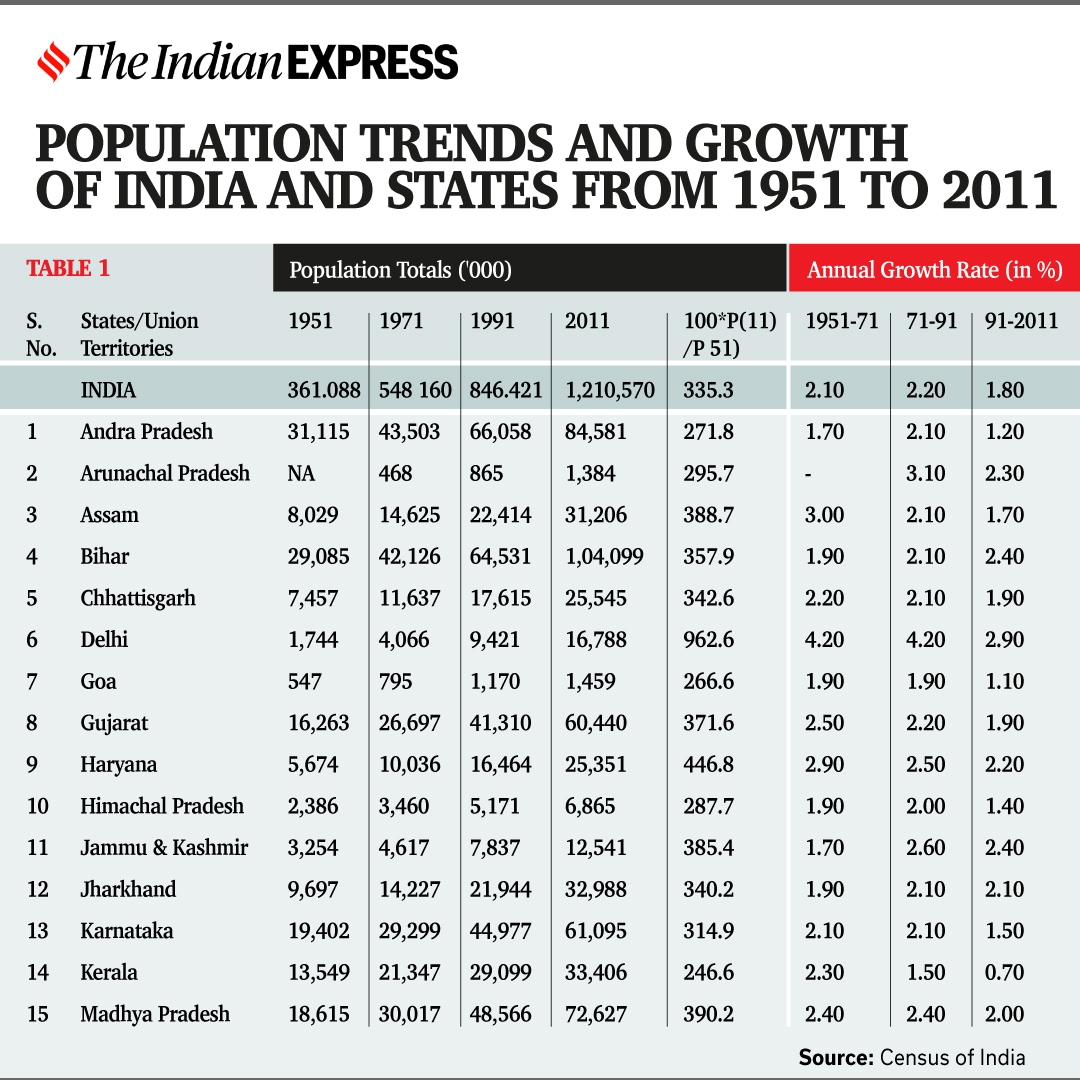 Population growth in India and the States (Source- Census of India/ graphics by Dinkar Sasi)
Population growth in India and the States (Source- Census of India/ graphics by Dinkar Sasi)
The first public expression of the need for family planning in the country was carried out by Pyare Kishen Wattal with the publication of a book, ‘The Population Problem in India’ in 1916 in which he advocated family limitation. A pioneering effort was led by Professor Raghunath Dhondo Karve when he opened the country’s first birth control clinic in Bombay in 1925. Karve was a professor of Mathematics and an activist on women’s rights. He advocated widow remarriage and the practice of artificial methods of family planning. However, his writings and speeches on the subject were met with severe opposition and he was asked to resign by the authorities of the Christian Missionary College where he worked. The next attempt in this direction was the forming of the Madras Neo-Malthusian League in July 1929, which published a propaganda journal called Madras Birth Control Bulletin.
The humble beginnings of population control that started in Bombay and Madras, however, did not spread rapidly because of Mahatma Gandhi’s strong opposition to artificial methods of birth control. For Gandhi, sexual abstinence was the only ethical means of birth control. In his magazine ‘Young India’ he wrote in 1936: “Sex urge is a fine and noble thing. There is nothing to be ashamed of in it, but it is meant only for the act of creation. Any other use of it is a sin against God and humanity. Contraceptives of a kind there were before and there will be hereafter, but the use of them was formerly regarded as sinful. It was reserved for our generation to glorify vice by calling it virtue.” (As cited in Srinivasan’s book).
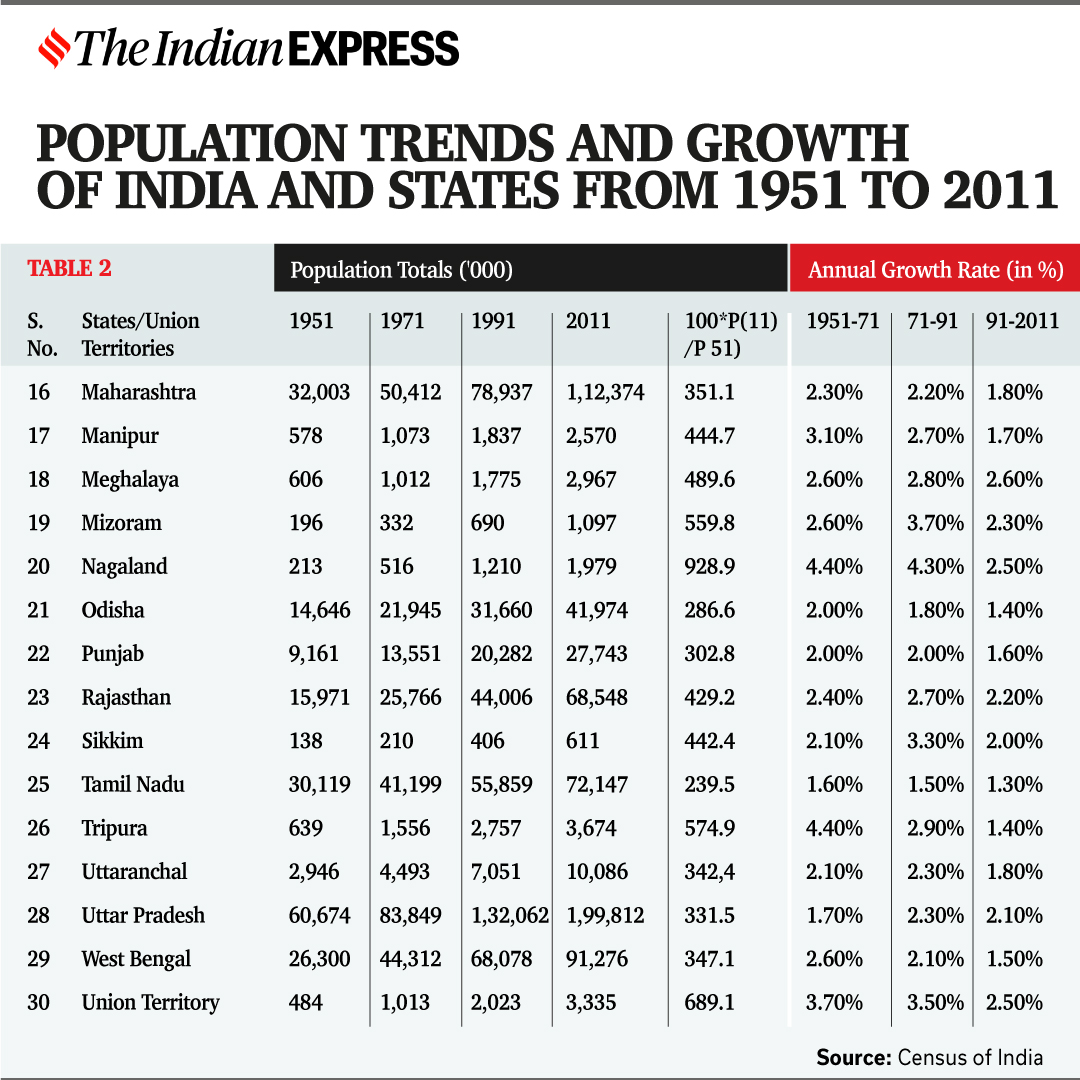 Population growth in India and the States (Source- Census of India/ graphics by Dinkar Sasi)
Population growth in India and the States (Source- Census of India/ graphics by Dinkar Sasi)
Gandhi’s views on birth control were strongly challenged by western activists, particularly Edith How-Martyn and Sanger, who advocated family planning as a means of liberating women from child bearing and improving their status as individuals in society.
The women’s movement in India and voluntary organisations continued to advocate for artificial methods of birth control despite Gandhi’s opposition. The annual meeting of the All India Women’s Conference in 1935 focused on birth control and invited How-Martyn and Sanger. “How-Martyn and Sanger took this opportunity to meet with Gandhi to discuss the use of artificial methods of family planning. Despite their efforts to convert him to their side, Gandhi stood firm in his conviction and rejected the use of artificial methods of family planning,” writes Srinivasan.
Jawaharlal Nehru, however, had an opposing view to Gandhi on the matter. He was influenced by the prevailing views on population in the west and was of the opinion that as modern technology made their way to the east, a significant population increase would result in India. Therefore he perceived the rising population of India as a burden that needed to be properly organised. As early as the mid 1930s the National Planning Committee under Nehru set up a subcommittee on population that recommended the gradual increase in age of marriage, the teaching of contraception in medical colleges, the establishment of birth control clinics, provision of free contraceptives and local manufacture of contraceptives, the education of people on the issue of population and the introduction of a eugenic program for sterilisation of people suffering from communicable diseases.
The efforts at population control was halted briefly with the onset of the Second World War in 1939. With the end of the war in 1945 and the Independence of the country in 1947 a new and more invigorated phase of population control plans was ushered in.
Family planning in five year plans of independent India
One of the earliest efforts at birth control was the formation of the family planning association of India. Its members included pioneers such as Professor Karve, Dr A. P. Pillay, Lady Dhanvanthi Rama Rau, Mrs Vembu and Mrs A. B. Wadia, who were active in family planning programmes before the war and had shown keen interest during the All India Women’s Conference held earlier in 1935. Founding of the association was a milestone moment both in the history of family planning in India and the world.
In 1952, during the first five year plan, the government assumed that rapid population growth would be a hindrance in the socio-economic development of the country. Accordingly, it adopted a ‘family limitation and population control programme’, arguably the first such attempt anywhere.
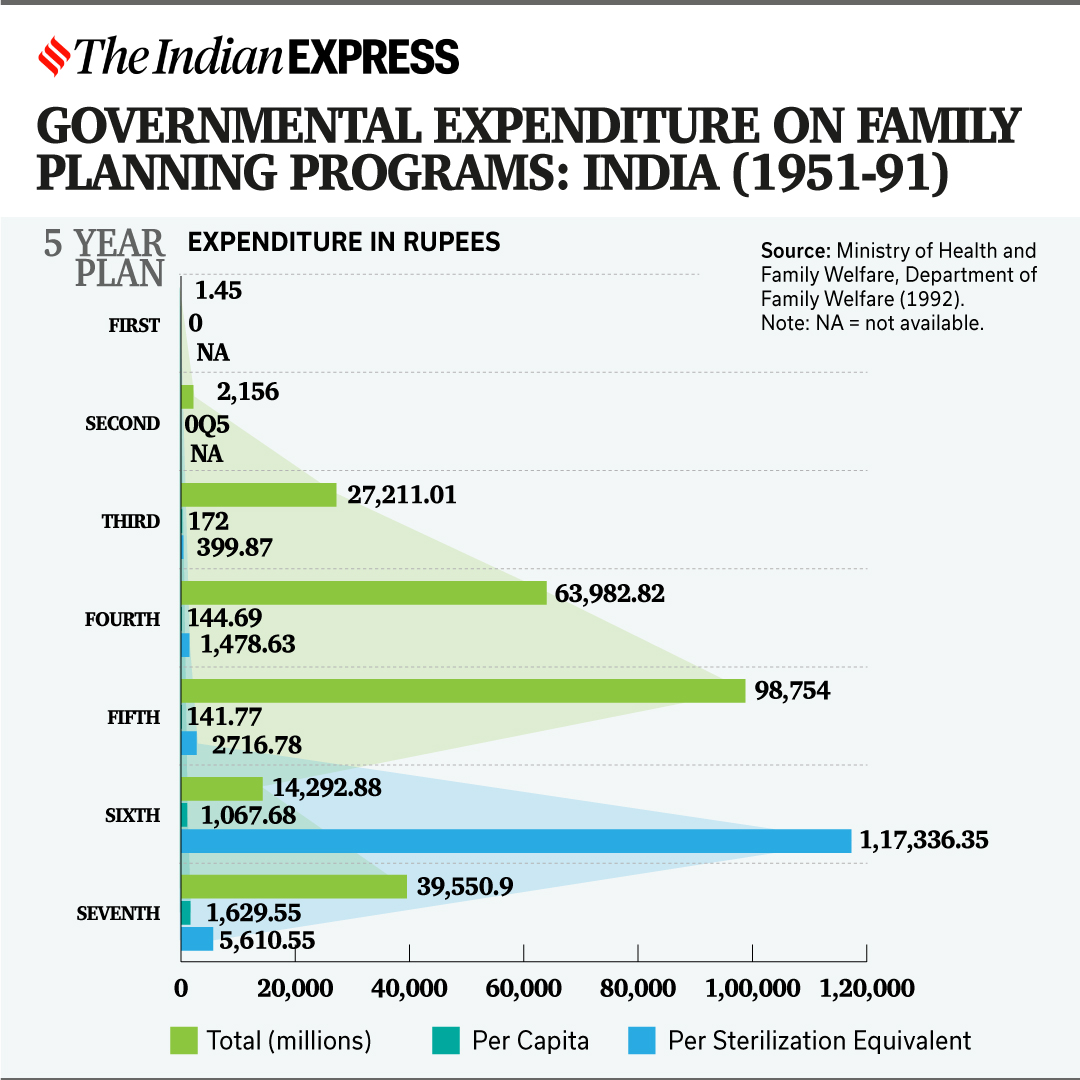 Government expenditure on family planning programs (Source- Ministry of Health and Family Welfare/ graphics by Dinkar Sasi)
Government expenditure on family planning programs (Source- Ministry of Health and Family Welfare/ graphics by Dinkar Sasi)
However, the programme made negligible progress, partly because there was very little experience to draw from. Moreover, its goal was defined in rather vague terms as that of reducing birth rate to the level necessary to stabilise the population at the level consistent with the requirements of the national economy. “But it also reflected continuing reservations about modern birth control methods,” writes Dyson in his book, ‘A population history of India: From the first modern people to the present day’ (2018). “Indeed in the late 1940s and early 1950s Rajkumari Amrit Kaur- a former secretary to M K Gandhi- was the country’s minister of health. Although she later changed her views, at that time she favoured family limitation through the practise of sexual abstinence.” Much of the budget kept aside for family planning programme at this phase was spent on doing research on the ‘rhythm method’(a form of natural contraception by which sexual intercourse is restricted to the times of a woman’s menstrual cycle when ovulation is least likely to occur) which was largely unsuccessful both in the west and in India.
The second five-year plan involved the opening of 1,430 family planning clinics and birth control services also began to be provided at private healthcare systems (PHCs). Family planning and health came under the jurisdiction of the states and in this regard we see a significant progress in birth control initiatives in the south. In particular, there were efforts at providing sterilisation services. In 1959, for instance, the Madras state government introduced a scheme by which people who were sterilised were given a small amount of money. There were restrictions on who could be sterilised though. By 1960, the states of Mysore, Maharashtra and Kerala also introduced similar schemes.
Influenced by the progress made by the southern states, the third five-year plan made sterilisation services available in PHCs as well. Several sterilisation centres were also established, mainly in the bigger cities. Dyson notes that the number of sterilisations carried out in India rose from 64,000 in 1960 to about 1.8 million by 1967-68.
A notable event in this regard took place in Ernakulam district of Kerala in December 1970 at the instigation of the district’s chief administrator, S.S. Krishnakumar. A sterilisation camp was established with much fanfare and quick and safe vasectomies were made available with sizable cash payments to those availing the service. About 15,000 vasectomies were carried out in the event. When a similar event was held once again in July 1971, once again in Ernakulam, it resulted in 63,000 vasectomies. Following this, similar camps were held in most states across the country. “It is estimated that about 91 per cent of the contraceptive ‘protection’ (i.e. against pregnancy) provided by the family planning programme in 1972–73 derived from sterilizations. Moreover, vasectomies accounted for 84 per cent of the sterilizations performed during 1972–73,” notes Dyson.
However, the 1971 census made clear that despite the many efforts, much to the frustration of policy makers, population growth had continued unabated during the decade. The population of the country rose from 439.2 million in 1961 to 548.2 million in 1971, which was a 24.8 per cent increase as compared to 21.5 per cent rise in the 1951-61 period. “This was because the government of the day had fixed very high targets to be achieved in a short period of time. The targets for each earlier five-year plan failed but the government kept keeping higher targets in the consecutive plan,” says Srinivasan. “Moreover, by diverting so much of time and money to sterilisations, we lost out on resources that should have been used to improve health infrastructure instead,” he adds.
The Emergency and forced sterilisations
In the period between 1960 to 1976 the international emphasis on family planning increased significantly with funding from the United States Agency for International Development (USAID), Ford Foundation and Rockefeller Foundations. Among all Asian and Sub-Saharan African countries, India’s family planning programme received the largest chunk of international aid. “The international push was so extreme that in 1965, President Lyndon B. Johnson refused to provide food aid to India—at the time threatened by famine—until it agreed to incentivize sterilization,” writes Prajakta R. Gupte in her article, ‘India: ‘The Emergency’ and the politics of mass sterilisation’ (2017).
The mass sterilisation campaign that took off during the Emergency declared by then Prime Minister Indira Gandhi needs to be seen in context of this international pressure on India. “These were based, with a hindsight, on the fear of the large populations of India, Pakistan, Bangladesh and Indonesia increasing very rapidly and posing a global threat to peace and prosperity of the Western world,” writes Sreenivasan. In the history of population control in India, this was the only period which saw the use of force.
With the opposition behind bars and the press silenced, several atrocities were carried out during the period of Emergency that lasted from June 1975 to March 1977. The most talked about among them was a forced sterilisation campaign, spearheaded by Gandhi’s son, Sanjay Gandhi, who held no official post in the government at that time. He came up with a five-point programme which included family planning, tree planting, a ban on dowry, an adult education programme and ending of social caste. In the opinion of Sanjay Gandhi, family planning was to be a way of life in India and he wanted rapid results. “For instance, he wanted to control the population within a year, beautify the city in weeks, and virtually end poverty overnight,” writes Gupte.
A National Population Policy (NPP), the first of its kind in India, was passed in the Parliament in April 1976. Sterilisation and in particular vasectomy was to be the core of this programme. States such as Uttar Pradesh, Bihar, Madhya Pradesh, Rajasthan, Orissa, Haryana, Punjab, and Himachal Pradesh also came up with their own sterilisation policies, and all of North India came to be known as the ‘vasectomy belt’. Each of these states began competing with each other to achieve the highest number of sterilisations.
Vasectomies were held in many government offices, railway stations, and schools. Sreenivasan notes how “the vasectomy booths set up in the Churchgate and VT stations in Mumbai became notorious because of its ruthless nature: they gathered the young male passengers getting down the electric trains and made them pass through the vasectomy booths and sterilized them, unless they have a card for already being sterilised.”
Further, the government issued circulars to employees stating that their promotions and payments would be held back unless they got sterilised or got an assigned quota of people to sterilise. “People had to produce a certificate of sterilization to get their salaries or even renew their driving/ rickshaw/scooter/sales tax license. Students whose parents had not undergone a sterilization were detained. Free medical treatment in hospitals was also suspended until a sterilization certificate was shown,” writes Gupte. Those who suffered the most were the poor and illiterate people, picked up from pavements, railway stations, or bus stops and forced to undergo the process.
As a result, the family planning programme’s performance in India during the 1976-77 period was the best that any country had ever achieved, with 8.26 million sterilisations. It is worth noting that it was during this period that China too officially adopted the one child policy, and one can assume that Gandhi and her son thought that a similar attitude of force might work in case of India too. However, as Sreenivasan notes, China used UIDs to achieve its goal, which was reversible unlike the case with sterilisations.
Soon enough violent revolts broke out in several parts of India in response to the forced sterilisations. Gupte writes that in Uttar Pradesh alone 240 cases of violent resistance were reported. “In Muzzaffarnagar, for instance, people resisted by pelting the police with stones. Again, the police opened fire, killing twenty-five people. After this incident, a curfew was imposed, and law enforcement officers killed violators,” she writes. A significant opposition to the programme came from the poorest areas and from the Muslims who thought it was the majority’s way of diminishing their community.
In an attempt to prove her popularity, Indira Gandhi called for fresh elections in February 1977. This was the beginning of the end of her power. The Congress party incurred huge losses both at the centre and in most of the states and one of the key election issues was the government’s imposition of a coercive family planning program. “A popular saying among the people at that time was that the compulsory sterilisation program brought down the government instead of the birth rate,” says Sreenivasan. “This is a lesson for any government in India.”
Looking back at the approach to population control during the Emergency, Dyson says that “what it did was weaken the commitment to family planning”. “The Australian demographer Jack Caldwell had argued that if Mrs Gandhi had continued with the Emergency then India would have achieved replacement fertility, that is two births per woman, by the 1980s. He may well have been right since India is only slightly above two births per woman now,” says Dyson. “There was a huge difference in India’s demographic trajectory as a result of Mrs. Gandhi losing the election. Had she won the election, it is interesting to speculate what she would have done with the family planning programme.”
Post-Emergency population control
The biggest change that took place after the 1977 general elections was that India’s population control policy shifted focus to voluntary efforts. “The Indian government now put more emphasis on incentives to attract people to accept family planning instead of coercive measures although the government still gave priority to the rapidly growing population problem,” writes sociologist Gabe T Wang in his paper, ‘Population control policies and implementations in India’ (2019). The name of the programme was changed from ‘family planning’ to ‘family welfare’ under the pretext that any population policy would put greater emphasis on maternal and child healthcare as well as nutrition.
A working group on population policy was set up under the planning commission in 1979. The group recommended a long term demographic goal of reaching a net reproduction rate of one by 1996 for the entire country and for the states by 2001. The government also emphasised on indirect measures such as spreading awareness through the use of media, education, giving larger share of central government’s assistance to states performing well and the like.
Further, states came out with policies of their own. Some states such as Assam, Odisha, Rajasthan, Maharashtra, Telangana and Andhra Pradesh, for instance, have some form of two-child policy in place to be eligible for certain government jobs. The Uttar Pradesh Law Commission in July 2021 submitted a proposal for barring any person with more than two children from contesting in local polls, applying for promotions in government jobs and from receiving government subsidy.
Visaria says that one of the biggest impacts of the forced sterilisation campaign carried out during the Emergency was that vasectomy or male sterilisation was put on the back burner. “Female sterilisation became more popular as women came forward despite it having a negative effect on their health,” she says. “We came to a stage when Indian doctors, for several years, were not even trained in the performance of vasectomy.”
“All kinds of incentives for sterilisation needs to be stopped immediately,” suggests Sreenivasan. “Not only does it impact women’s health but also it makes such a dent in fertility that cannot be restored later.” “China could reverse its one child policy because it did not have so many sterilised people. But in India, a majority of family planning efforts continue to be through female sterilisations” he says.
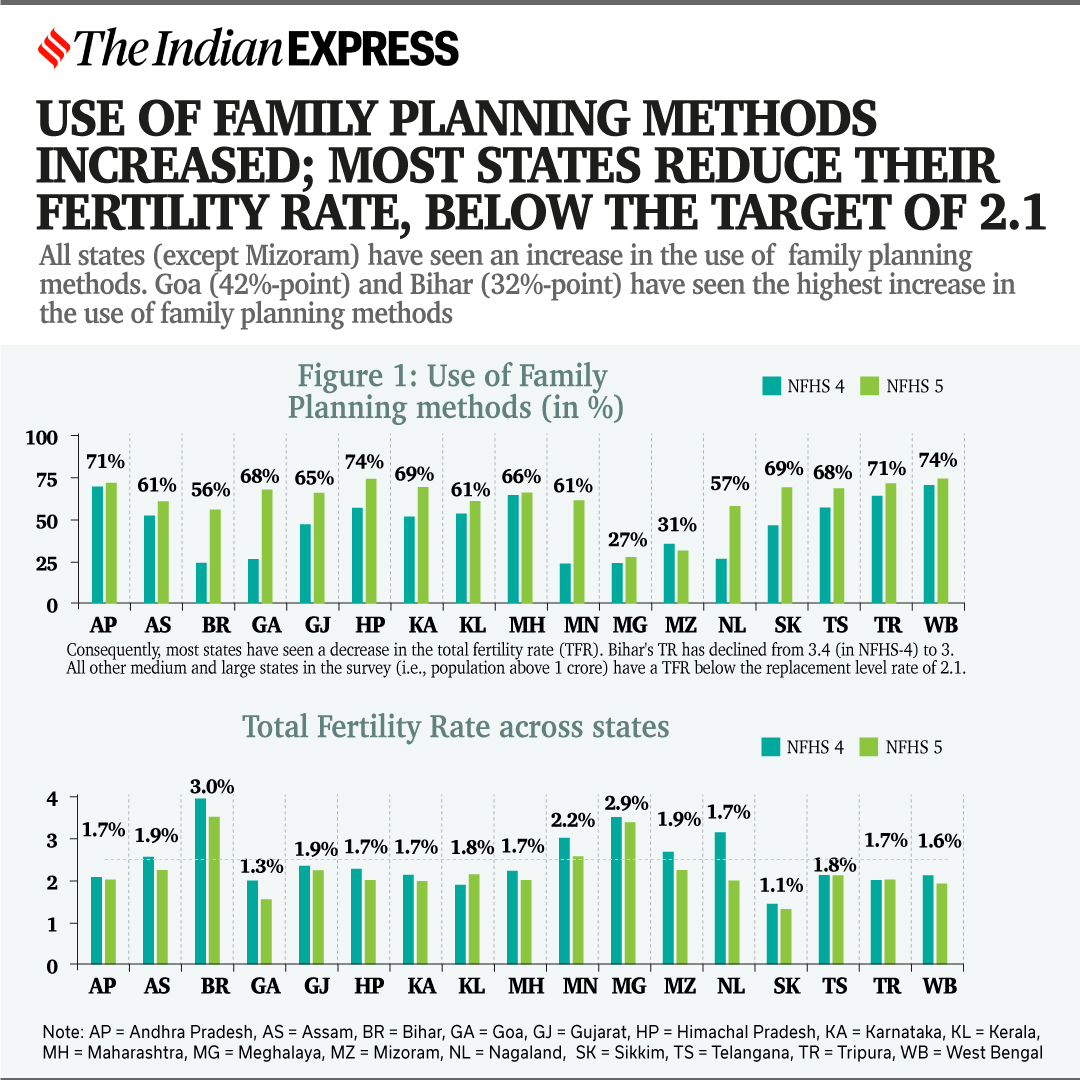 The total fertility rate across most of India is close to two. (Source- NHFS/ graphic by Dinkar Sasi)
The total fertility rate across most of India is close to two. (Source- NHFS/ graphic by Dinkar Sasi)
Despite the variegated efforts in India’s family planning initiatives, population continues to be seen as a problem in the country. A 2019 report released by the United Nations predicted that India’s population would surpass that of China by 2027 and that it would remain the most populous country of the world till the end of the century.
“That is bound to happen since it’s built in the momentum of the population. We had until very recently very high fertility levels and all those children born in the 1970s and 80s will want to have one or two children and till that phase of transition is completed the population will continue to grow in absolute numbers,” says Visaria.
However, she believes that despite the growth in population the country does not need a population control policy. “The latest NHFS data clearly indicates that the total fertility rate is now two, which is slightly below replacement levels. The NHFS surveys have demonstrated that no Indian couple want more than two children,” she says. “What we need is to ensure that good quality services are available to all regardless of rural, urban, caste or religion.”
Srinivasan believes that the condition of population India at present with its demographic diversity is in fact at an advantageous stage. “At present different states are at different levels of demographic transitions. For instance Bihar, Madhya Pradesh, Uttar Pradesh, Rajasthan are still slightly above replacement level of fertility. Whereas Tamil Nadu, Kerala, Andhra Pradesh, Karnataka, Goa, Pondicherry are well below replacement level of fertility,” he says. “This is an advantage for a country because the labour shortage in one state can be filled up by surplus labour in another state, provided we facilitate internal migration.”
He also suggests that any population policy at this stage is bound to recoil because it will appear to be directed towards a particular community. The only form of family planning that he says must be advocated is the kind that was advocated by Margaret Sanger: “wherein couples have babies by choice and not by chance.”
Further reading:
Krishnamurthy Srinivasan, ‘Population concerns in India: Shifting trends, policies and programs’, Sage Publications, 2017
Tim Dyson, ‘A Population History of India: From the first Modern People to the Present Day’, Oxford University Press, 2018
Prajakta R. Gupte, ‘India: The “Emergency” and the politics of mass sterilisation’, Association for Asia Studies, 2017
Gabe T. Wang, ‘Population control policies and implementations in India’, Journal of Sociology and Social Work, 2019
Matthew Connelly, ‘Population control in India: Prologue to the Emergency period’, Population and Development Review, 2006
Apr 24: Latest News
- 01
- 02
- 03
- 04
- 05







































